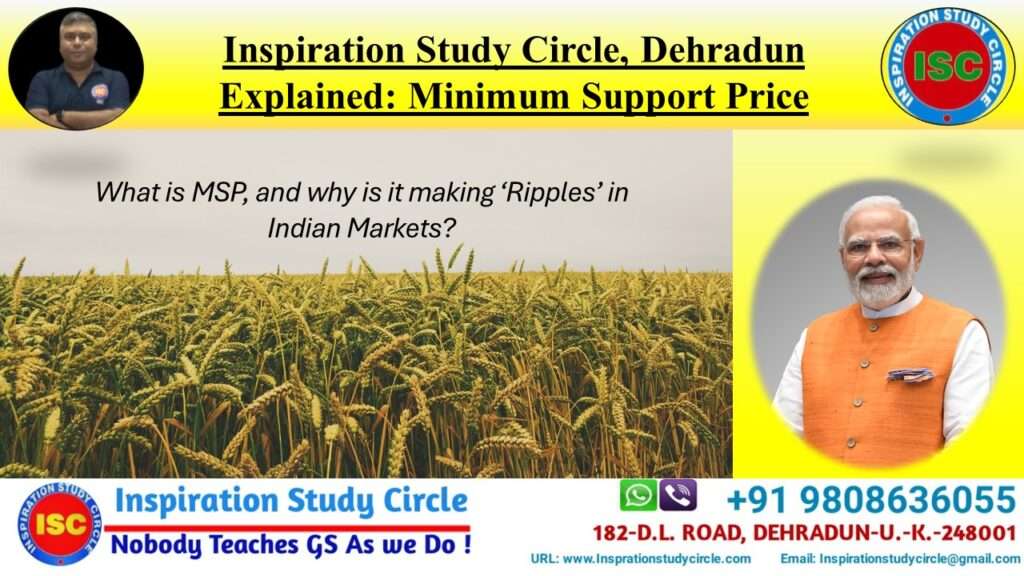
UPSC Mains 2025 Analysis and Overview
UPSC Mains 2025 Analysis and Overview Table of Contents The UPSC Mains 2025 analysis indicated a paper that was a balance of static and analytical questions,
In the recent context of events in the country, the Center has announced an increase in the minimum support price (MSP) for wheat and five other Rabi crops for the 2024-25 marketing season. Additionally, the Indian government has also approved the minimum support price (MSP) for kharif crops for the 2023-24 season, aiming to pay fair wages to farmers.
However, farmers’ organizations have expressed concern that the cost of production may not match the increase.

The Government of India started announcing the Minimum Support Prices (MSP) in 1966-67 for wheat which was expanded to cover many more crops in the coming years in the wake of the Green Revolution which might have resulted in a fall in wheat prices depleting farmers’ profit. It is a minimum price at which the government will purchase farmers’ crops- irrespective of The Minimum Support Price (MSP) is a price floor set by the Indian government for purchasing farmers’ crops, regardless of the market price. It was first introduced in 1966-67 for wheat and later extended to other crops. The MSP was created to prevent a fall in wheat prices that could hurt farmers’ profits.
Procurement Prices: Besides MSP, the government also announced procurement prices after the harvest. These were higher than the MSP to encourage farmers to sell their crops to the government, which needed to maintain buffer stocks.
Since the fiscal 1968-69, the government announced only the MSP which is considered the procurement price, too.
The Decentralized Procurement Scheme of the Government of India has been in operation since 1997 and has evoked a good response from the State Governments. Under this scheme, the designated States procure, store, and issue foodgrains under TPDS. The difference between the economic cost of the State Governments and the central issue price (CIP) is passed on to the State Governments as a subsidy. The Decentralized system of procurement helps to cover more farmers under the MSP operations, improves the efficiency of the PDS, provides varieties of foodgrains more suitable to local taste, and reduces the transportation costs of the FCI.
It must be noted that MSPs serve as floor prices and are set by the government as a long-term guarantee for producers’ investment decisions and guarantee that commodity prices will not be allowed to fall below government-set levels, even in the event of bumper cuts. The procurement price is the price of kharif and rabi seeds that must be purchased domestically by government agencies (such as FCI) to be released through PDS. It was announced after the production started. Usually, the purchase price is lower than the open market price and higher than the MSP. The policy of announcing two official prices continued with some variations in the case of raw materials till 1973-74. In the case of wheat, it was suspended in 1969 and revived for only one year in 1974-75. As there were many demands to strengthen the MSP, in 1975-76 this system evolved into a system where only one set of wheat purchase prices was announced for the raw material (and other kharif crops) and the buffer stock.
MSP is a guaranteed amount paid to farmers when the government purchases produce. MSPs are based on the recommendations made by the Commission on Agricultural Costs and Prices (CACP) recognizing factors such as production costs, demand and supply, market price trends, price parity between crops, etc.
The MSP aims to provide remunerative prices to growers for their produce and encourage crop diversification.
In formulating recommendations on the minimum support price level, the Commission considers the following factors in addition to the broad view of the overall structure of the commodity economy or a certain group of commodities: –
The Commission collects data at the micro level, at the district, the state, and the national levels. The information/information used by the Board includes the following:
The government announces Minimum Support Prices for 22 staple crops and a Fair and Remunerative Price (FRP) for sugar. The dominant crops are 14 Kharif crops, 6 Rabi crops, and two other commercial crops. In addition, the MSPs of toria and de-husked coconut are determined based on the MSPs of mustard and copra, respectively. The List of Crops is as follows:
Kharif Crops: Kharif crops, also known as monsoon crops or autumn crops, are domestic crops grown and harvested in India, Pakistan, and Bangladesh during the Indian subcontinent’s monsoon season, which lasts from June to November, depending on the region. Monsoon rains can begin in parts of the Indian subcontinent in early May, and crops are usually harvested from the third week of September to October. Rice, Maize, and Cotton are the main Kharif crops in India.
Rabi Crops: Rabi crops are known as winter crops. It is cultivated in October or November. The crop is then harvested in the spring. This plant requires frequent watering because it grows in dry areas. Wheat, Gram, and Barley are some of the rabi crops grown in India.
CACP projects three types of production costs for each crop at state and all-India average levels:
CACP usually considers A2 + FL and C2 costs when recommending MSP.
In recent developments, farmers mainly from Punjab, Haryana, and Uttar Pradesh started their ‘Chalo Delhi’ march after an inconclusive meeting with the central government.
The legal guarantee of Minimum Support Price (MSP) is the main cause of farmers’ protests. Besides, the farmers have demanded the implementation of Swaminathan Commission recommendations (2006) as well as farm debt waiver.
There are several reasons why MSP is considered important in India:
It’s important to note that while MSP has several benefits, discussions and debates continue on its effectiveness, implementation, and potential impact on market dynamics.
The Debate surrounding the ‘Law on MSP’
The Minimum Support Price (MSP) system in India has been a subject of debate and discussion for many years. The debates surrounding MSP primarily revolve around the following key points:
On the other hand, supporters of MSP argue that it is necessary to protect the interests of farmers, particularly small and marginal farmers who are vulnerable to market fluctuations. They believe that MSP provides income security, reduces farmer distress, and ensures food security for the country. Supporters argue that MSP acts as a safeguard against exploitation by intermediaries and provides a safety net for farmers during times of crop failure or price volatility.
It’s important to note that the debate on MSP in India is complex, and opinions on its effectiveness and impact can vary among different stakeholders, including farmers, policymakers, economists, and agricultural experts.
Way Forward for Indian Markets
To address the concerns and improve the effectiveness of the Minimum Support Price (MSP) system in India, several potential ways forward have been suggested:
Regular evaluation and monitoring of the MSP system’s impact are vital to identify areas for improvement and maintain its effectiveness and sustainability.
Disclaimer: the information for the above article is taken from: Vikaspedia, a portal of Ministry of Electronics and Information Technology, Government of India, and Indian Express.

UPSC Mains 2025 Analysis and Overview Table of Contents The UPSC Mains 2025 analysis indicated a paper that was a balance of static and analytical questions,

Last Minute Preparation Tips for UP PCS Prelims 2025 Table of Contents The Uttar Pradesh Public Service Commission conducts a series of annual examinations for

Explained: Next-Gen GST Overhaul and Reforms Table of Contents The GST Council in its 56th meeting on 3rd September, 2025, made the recommendations relating to changes in

Explained: Vikram-32 Chip Table of Contents Union Information and Broadcasting Minister Ashwini Vaishnaw recently unveiled India’s first indigenously developed 32-bit processor called VIKRAM-32. The minister presented the

UPSC Prelims 2026 Test Series Table of Contents Inspiration Study CircleUPSC Prelims 2026 Test Series The Union Public Service Commission (UPSC) is set to conduct

UPPSC- PCS 2025 Prelims Test Series UPPSC 2025 प्रारंभिक परीक्षा टेस्ट सीरीज़ उत्तर प्रदेश लोक सिविल सेवा 12 अक्टूबर 2025 को अपनी उच्च और संयुक्त